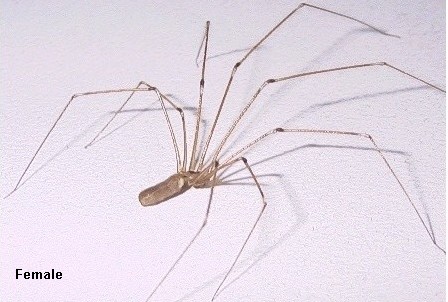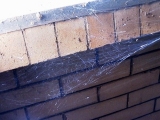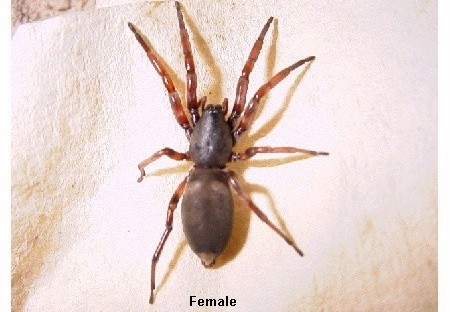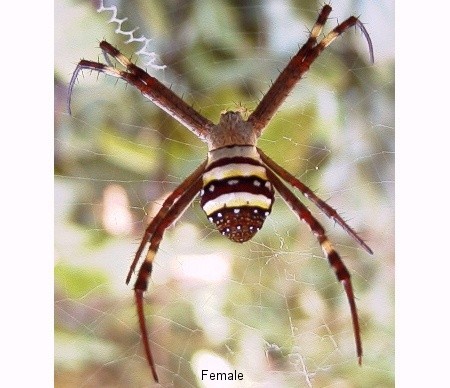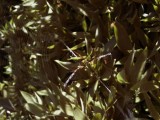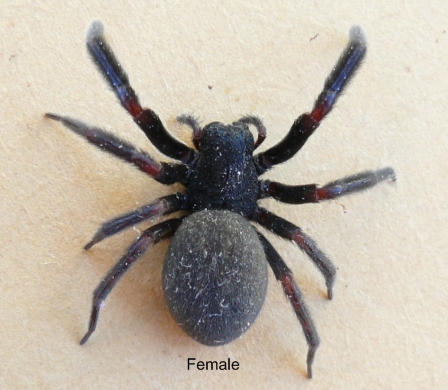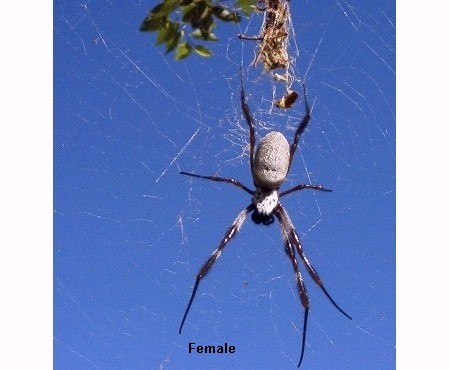Spiders
Daddy Long Legs Spider
|
|
||||||||||||||||||||||||||||
A noteworthy characteristic of this spider is its habit of shaking the web violently when disturbed. The female will often be found holding her eggs in her palps.
Spider(s) with a very similar appearance: Any other pholcid with an elongate abdomen.
Information and pictures on the Daddy Long Legs Spider is kindly reproduced with permission from Dr Ron Atkinsons Find a Spider Guide for Spiders of Southern QLD
White-tailed spider
|
|
|||||||||||||||||||||||||||
This species has previously been identified by most people as Lampona cylindrata but recent taxanomic work has indicated that it is a different, though closely related, species. According to Platnick, L. cylindrata is mostly found in southern parts of Australia whereas L. murina is the equivalent species in the northern half of the continent.
Both the cephalothorax and abdomen of this spider are tapering cylinders coloured satin black. The fovea on the carapace runs lengthwise rather than across as it does on many other spider species. The distinctive off-white spot at the rear end of the abdomen gives this spider its common name. Two lateral pairs of pale spots are also seen on the upper surfaces of the abdomen, especially in immature specimens.
White tailed spiders are known to feed obligatorily on other spiders, especially the black house spider, and can be found almost anywhere in a house or other rural building. They are most likely to roam at night and can drop down from the ceiling onto beds.
Recent toxicological reports have cast strong doubts about the ability of white-tailed spiders to cause development of large areas of long-lasting skin ulceration when they bite humans.
Spider(s) with a very similar appearance: Some other lamponid species.
Information and pictures on the White Tailed Spider kindly reproduced with permission from Dr Ron Atkinsons Find a Spider Guide for Spiders of Southern QLD
St. Andrews Cross
|
|
|||||||||||||||||||||||||||||||
The common name of this species is derived from its habit of producing and resting on a stabilimentum, which is a cross of serrated (zigzag) silk. In one season an adult female will produce several leaf-like, green egg sacs, these being attached to a wall or tree trunk in close proximity to the web.
Males lack the bright colours of the females and are much smaller. Juveniles are also pale and reside on very small circular webs which can often be found in quite large numbers.
Spider(s) with a very similar appearance: Argiope picta and Argiope magnifica.
Information and pictures on the St Andrews Cross Spider kindly reproduced with permission from Dr Ron Atkinsons Find a Spider Guide for Spiders of Southern QLD
Black house spider
|
|
|||||||||||||||||||||||||||
This spider is often called the black house spider or window spider because it frequently builds webs in the crevices around doors and windows. Note that it does not normally establish itself inside buildings. It is said to be a favourite food of the white-tailed spider, Lampona murina.
Spider(s) with a very similar appearance: Badumna longinqua.
Information and pictures on the Black House Spider kindly reproduced with permission from Dr Ron Atkinsons Find a Spider Guide for Spiders of Southern QLD
Golden orb-weaver
|
|
||||||||||||||||||||||||
This species exhibits striking sexual dimorphism, the small male often waiting on the periphery of the web. An important characteristic of the female is the present of black brushes along the legs.
The web is remarkably strong and has a characteristic yellow colour as does the fluffy egg sac which tends to be left in the tree the spider was using for support. Nephila webs normally contain a string of debris masses which are the remains of insects the spider has eaten. The tendency to produce such a string is rare among orb weaver species so this is a useful identification feature.
In many parts of south-east Queensland this species is present in very large numbers, especially throughout the warmer months of the year. It is common for a single dead tree to have as many as 30 individual golden orb-weaver webs attached to it.
Spider(s) with a very similar appearance: Nephila plumipes and Nephila pilipes
Information and pictures on the Golden Orb Weaver Spider kindly reproduced with the kind permission of Dr Ron Atkinsons Find a Spider Guide for Spiders of Southern QLD




